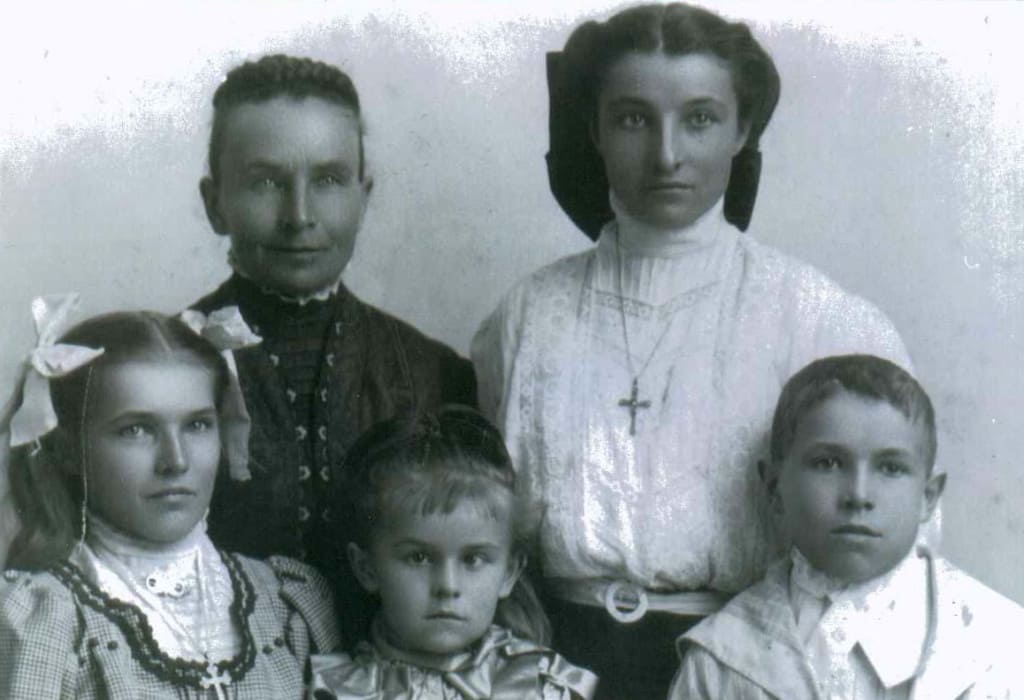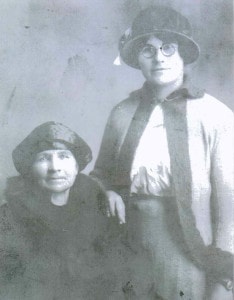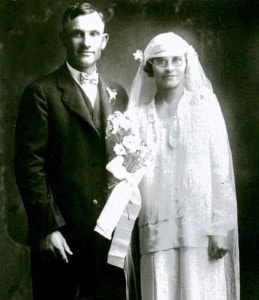An American Girl — My Great-Grandmother, Christine Henk
By Lexi Hutton, age 10. Submitted by Connie Schield, Stone Lake Area Historical Society.

Christine was born on December 12, 1905 at home in a log cabin built by her father. She was the fourth child of Bertha and Joseph Herman. Her family had crossed the ocean in a ship called the S.S. Hannover on March 24, 1900. They came from Czechoslovakia and arrived in Baltimore on June 7, 1900. They then travelled by rail to New York, then to Chicago and Spooner and on to Hayward, Wisconsin.
Christine’s family participated in the Homestead Act. They selected 160 acres in a forest of pines and made a trail to the main road Highway 27. They had to live on the land and improve it for five years before it became their property. Because they spoke very little English, Joseph used a catalog at a store to point to what he needed: a cant hook, axe, grub hoe and scythe. The Matt Kadlec family welcomed the Herman family into their home to live with them for a few months until their log cabin was built.
The barn was divided by a log wall. The family lived in one half of the barn and the horse, cow and ten hens lived in the other half. The horse was used to haul water in wooden barrels from Colbroth Lake before their well was dug. The family started clearing the land for farming and gardening.
On April 29th, 1909, the Sawyer County Record headlines were “Buried in ninety foot well.” It took seventeen days, three shifts of men digging, to finally dig up Christine’s father. Christine was only four years old when the well collapsed on her father. Bertha, Christine’s mother never learned to speak English. What would she do with four children and 160 acres of land.
Mary, Christine’s sister, was 15 years old and snared rabbits for food. The rabbits were skinned out, and hides were stretched over shoes to dry, and used to keep their feet warm. Every Tuesday and Saturday cream was hauled seven miles in the Hayward Creamery to sell. One winter, when the horses died, Mary and Rose trained a young bull to pull the wagon. By spring, he was able to haul a stone boat, drag stone, wood and even hauled water in barrels. There was no fresh drinking water because their well had caved in.

Christine, Stanley, Mary and Rose helped their mother farm. They grew vegetables, picked berries, and raised chickens and pigs. There was no electricity or iceboxes or any way to keep meat; so they lived mostly on cheese, eggs, potatoes, dried beans and cottage cheese. Chicken was served only on Sunday after attending Mass at St. Joseph’s Catholic Church in Hayward.
Christine helped her siblings trap muskrats and weasels to sell their hides. Muskrats brought 18 cents a hide and weasels brought 28 – 33 cents a hide. Eggs from the chickens sold for 10 cents a dozen. Sometimes they would exchange a dozen eggs for a ring bologna. During the winter months, pork was eaten, but had to be used up by spring. The lard was used to fry doughnuts, but the grease was also used for making soap. Kerosene lamps were used for lighting, but at 17 cents a gallon, it was “early to bed.”
In 1912, Christine’s two sisters, Mary age 18 and Rose age 16 got married and moved out leaving Christine, age 7 and Stanley age 13 to work the 160 acres with their mother. Christine attended Boylan School which was a one room schoolhouse. Her mother said it was important for her to learn all that she could.
Stanley purchased a mower to help cut the grain. Stanley was too short to operate the foot-levers, so Christine’s mother drove the horses walking in behind the mower, while Christine held onto the big handle that lifted the sickle bar over the stumps and rocks.
In 1920 a car was purchased. After that, cream was sold and groceries were bought in just a few hours, leaving more time for other chores. There were still berries to be picked and garden to be weeded.

On August 29, 1927, Christine married Henry Henk and started a family of her own. Her first child, Esther, was born in 1928. The doctor came to the house and charged a $35 fee. They had eight children who were all born at home with the help of relatives and possibly a doctor.
Electricity didn’t come to the area until 1940. Water was pumped from the well using a hand pump and was heated on the wood stove for baths and dishes. The children used homemade skis to get to school in the heavy snow. They carried their lunches in empty syrup pails. Lunches included sandwiches soaked in syrup, a boiled egg and maybe an apple or cookie. Jackets and snow pants were made of wool with a flannel lining. Caps and mittens were homemade out of wool yarn. Every spring sap was collected from Maple trees for syrup, and summertime brought berries, plums and fresh vegetables from the garden.
Henry would get up at 5 A.M. and start a fire in the wood stove before going to the barn to start chores. Christine got up a little later to make breakfast in the chilly kitchen. The crock or pail that held the drinking water had ice on top. The children’s jackets, hung on the wall behind the kitchen door, often had frost on them or were frozen to the wall. The door from the living room to the kitchen was closed at night to keep any heat in the living room and stairway to the upstairs. Water for washing was brought up the hill from the pump house in ten-gallon cans on a stone boat pulled by horses. Water was heated in the copper boiler on the kitchen stove. In the summer, big wooden barrels sat under the kitchen eaves to catch rain water for washing. Christine used a big tin tub and a scrubbing board to get the laundry clean. The items were hung to dry outside in the summer and winter. Sometimes the clothes were brought in frozen from the clotheslines and hung in the living room to thaw and finish drying. Diapers had to be washed every day.
Christine and Henry had a dozen cows which they milked both morning and evening. The milk was sold to the local creamery. When the children were small, they had to be in the barn with their parents. Every spring Christine sent for 100 chickens which the mail carrier would deliver. There was a henhouse for the laying hens and Christine would sell the eggs. Next to the henhouse was a corn crib which held ears of corn to feed the chickens and pigs. Friends and neighbors got together and helped each other at threshing time, silo filling time and wood sawing time. The women of the household would fix a big meal for the workers.
Henry had a stroke in 1955 and it was decided to move into the Village of Stone Lake so it would be easier for Christine to take care of him. Now they had running water and electricity. Christine remained very busy with various jobs working at a cranberry marsh, picking beans, and cleaning resorts on Saturday. She still raised her chickens and had a large garden. She enjoyed entering things in the Sawyer County fair every year. She retired at age 73, but continued to help others. Her door was always open. She continued gardening and entering things in the Sawyer County Fair until age 95.



You must be logged in to post a comment.